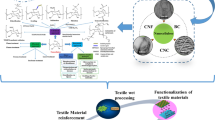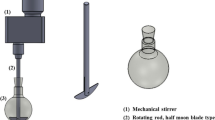Abstract
The use of nano- or microfibrillar cellulose (NFC or MFC) in papermaking is generally hampered by high cost and potentially wasteful use in typical wet end applications. The solubility and fines nature of the material makes it inefficient to retain, and when retained it is generally inefficiently applied within the spatial distribution of the paper fibre matrix. The benefits of capturing the important NFC in a layer structure, to enhance surface and stiffness properties of paper, board and laminates whereby NFC is entrapped at the surface of a fibrous web by forming an in situ composite, were previously shown for the exemplified case of modified porous calcium carbonate, as might be used in an inkjet coating application (Ridgway and Gane in Cellulose 19(2):547–560, 2011). The NFC is seen to integrate itself within the larger interparticle porous structure providing excellent holdout and thin layer continuity, essential in developing an efficient concentration of the NFC at the surface of the substrate. The effect is likened to the well-known I-beam construction. The concept need not be confined to porous pigments, as any pigment coating structure that absorbs and holds the NFC, thus creating an in situ composite, could be used. The aim of this study is to look at a range of different pigments and investigate how these could be used as coating structures by measuring the effect on the pore structure before and after absorbing NFC. This is achieved by using model porous tablet blocks made from the respective anionic coating formulations. The penetration of cationic starch solution, as might be applied for surface sizing on paper, is studied for comparison. The use of cationic starch is considered in the industry to provide reasonably effective surface concentrations due to the electrostatically driven adsorption to the anionic pore surfaces. The effect of water alone on the coating structure has also been measured to allow for structural relaxation, considered to be mainly related to the swelling properties of the anionic polyacrylic coating pigment dispersant. The results illustrate the size-exclusion properties of the pore structure in relation to the material being absorbed and partial resistance to bulk penetration by pore wall adsorption in the case of oppositely charged species. The distribution of the absorbate throughout the pore network can be derived using mercury intrusion porosimetry and electron microscopy, and is deemed critical in respect to controlling the end performance properties, be they, for example, barrier, strength-enhancing applications, or both.





















Similar content being viewed by others
References
Araki J, Wada M, Kuga S, Okano T (1998) Flow properties of microcrystalline cellulose suspension prepared by acid treatment of native cellulose. Colloids Surf A Physicochem Eng Aspects 142:75–82
Aulin C, Johannson E, Wågberg L, Lindström T (2010) Self-organized films from cellulose/nanofibrils using the layer-by-layer technique. Biomacromolecules 11(4):872–882
Bradford SA, Simunek J, Bettahar M, Van Genuchten MT, Yates SR (2003) Modelling colloid attachment, straining and exclusion in saturated porous media. J Environ Qual 34:469–478
Bradford SA, Torkzaban S, Leij F, Simunek J, Van Genuchten MT (2009) Modeling the coupled effects of pore space geometry and velocity on colloid transport and retention. Water Resour Res 45:1–15
Bruce DM, Hobson RM, Farrent JW, Hepworth DG (2005) High performance composites from low-cost plant primary cell walls. Compos Part A Appl Sci Manuf 36(11):1486–1493
Brunauer S, Emmett PH, Teller E (1938) Adsorption of gases in multimolecular layers. J Am Chem Soc 60:309–319
Cherian BM, Pothan LA, Nguyen-Chungm T, Mennig G, Kottaisamy M, Thomas S (2008) A novel method for the synthesis of cellulose nanofibril whiskers from banana fibers and characterization. J Agr Food Chem 56:5617–5627
Cowie JMG (1961) Studies on amylose and its derivatives. Part I. Molecular size and configuration of amylose in various solvents. Macromol Chem 42:230–247
Diaz J, Rendueles M, Diaz M (2010) Straining phenomena in bacteria transport through natural porous media. Environ Sci Pollut Res 17(2):400–409
Eichhorn SJ, Dufresne A, Aranguren M, Marcovich NE, Capadona JR, Rowan SJ, Weder C, Thielmans W, Roman M, Renneckar S, Gindl W, Veigel S, Keckes H, Yano H, Abe K, Nogi M, Nakagaito AN, Mangalam A, Simonsen J, Benight AS, Bismarck A, Berglund LA, Peijs T (2010) Review: current international research into cellulose nanofibres and nanocomposites. J Mater Sci 45:1–33
Flory PJ, Fox TG (1951) Treatment of intrinsic viscosities. J Am Chem Soc 73:1904–1908
Fukuzumi H, Saito T, Iwata T, Kumamoto Y, Isogai A (2009) Transparent and high barrier films of cellulose nanofibers prepared by TEMPO-mediated oxidation. Biomacromolecules 10:162–165
Gane PAC, Koivunen K (2010) Relating liquid location as a function of contact time within a porous coating structure to optical reflectance. Transp Porous Media 84:587–603
Gane PAC, Kettle JP, Matthews GP, Ridgway CJ (1996) Void space structure of compressible polymer spheres and consolidated calcium carbonate paper-coating formulations. Ind Eng Chem Res 35(5):1753–1764
Gardner DJ, Oporto GS, Mills R, Samir MASA (2008) Adhesion and surface issues in cellulose and nanocellulose. J Adhes Sci Technol 22:545–567
Hamada H, Bousfield DW (2010) Nano-fibrillated cellulose as a coating agent to improve print quality of synthetic fiber sheets. In: TAPPI 11th Advanced Coating Fundamentals Symposium, Munich, TAPPI, Atlanta, GA, pp 7–16
Hassan EA, Hassan ML, Oksman K (2011) Improving bagasse pulp paper sheet properties with microfibrillated cellulose isolated from xylanase-treated bagasse. Wood Fiber Sci 43:76–82
Henriksson M, Henriksson G, Berglund LA, Lindström T (2007) An environmentally friendly method for enzyme-assisted preparation of microfibrillated cellulose (MFC) nanofibers. Eur Polym J 43:3434–3441
Herrick FW, Casebier RL, Hamilton JK, Sandberg KR (1983) Microfibrillated cellulose: morphology and accessibility. J Appl Polym Sci 37(9):797–813
Hult E-L, Lotti M, Lenes M (2010) Efficient approach to high barrier packaging using microfibrillar cellulose and shellac. Cellulose 17:575–586
Kaiser C (1997) A directed percolation model for clogging in a porous medium with small inhomogeneities. Transp Porous Media 26(2):33–146
Klemm D, Kramer F, Moritz S, Lindström T, Ankerfors M, Gray D, Dorris A (2011) Nanocelluloses: a new family of nature-based materials. Angew Chem Int Ed 50(24):5438–5466
Kulicke W-M, Clasen C (2004) Viscosimetry of polymers and polyelectrolytes. Springer, New York
McGechan MB (2002) Transport of particulate and colloid-sorbed contaminants through soil, part 2, trapping processes and soil pore geometry. Biosyst Eng 83(4):387–395
Moerseburg K, Chinga-Carrasco G (2009) Assessing the combined benefits of clay and nanofibrillated cellulose in layered TMP-based sheets. Cellulose 16(5):795–806
Nakagaito AN, Yano H (2005) Novel high-strength biocomposites based on microfibrillated cellulose having nano-order-unit web-like network structure. Appl Phys A Mater 80(1):155–159
Paakko M, Ankerfors M, Kosonen H, Nykänen A, Ahola S, Österberg M, Ruokolainen J, Laine J, Larsson PT, Ikkala O, Lindström T (2007) Enzymatic hydrolysis combined with mechanical shearing and high-pressure homogenization for nanoscale cellulose fibrils and strong gels. Biomacromolecules 8(6):1934–1941
Pimpa B, Muhammad SKS, Hassan MA, Ghazali Z, Hashim K, Kanjanasopa D (2007) Effect of electron beam irradiation on physicochemical properties of sago starch. Songklanakarin J Sci Technol 29:759–768
Price JC, Matthews GP, Quinlan K, Sexton J, Matthews AG (2009) A depth filtration model of straining within the void networks of stainless steel filters. AIChE J 55(12):3134–3144
Rees LH (1974) Evaluating homogenizers for chemical processing. Chem Eng 13:86–92
Ridgway CJ, Gane PAC (2003) Bulk density measurement and coating porosity calculation for coated paper samples. Nord Pulp Paper Res J 18:24–31
Ridgway CJ, Gane PAC (2011) Constructing NFC-pigment composite surface treatment for enhanced paper stiffness and surface properties. Cellulose 19(2):547–560
Ridgway CJ, Gane PAC, Schoelkopf J (2004) Modified calcium carbonate coatings with rapid absorption and extensive liquid uptake capacity. Colloids Surf A 236(1–3):91–102
Ridgway CJ, Kukkamo V, Gane PAC (2011a) Effects of binders and additives on inkjet coating pigment pore structures. In: Tappi PaperCon ‘11 Conference, Covington, TAPPI, Atlanta GA, pp 1305–1319
Ridgway CJ, Schoelkopf J, Gane PAC (2011b) Competitive absorption of polar and non-polar liquids into latex bound porous structures of fine ground calcium carbonate. Transp Porous Media 86:945–964
Saito T, Isogai A (2007) Preparation of cellulose single microfibrils from native celluloses by TEMPO-mediated oxidation. Cellulose Commun 14(2):62–66
Saito T, Nishiyama Y, Putaux JL, Vignon M, Isogai A (2006) Homogeneous suspensions of individualized microfibrils from TEMPO-catalyzed oxidation of native cellulose. Biomacromolecules 7(6):1687–1691
Schoelkopf J, Gane PAC, Ridgway CJ, Matthews GP (2000a) Influence of inertia on liquid absorption into paper coating structures. Nord Pulp Paper Res J 15(5):422–430
Schoelkopf J, Ridgway CJ, Gane PAC, Matthews GP, Spielmann DC (2000b) Measurement and network modeling of liquid permeation into compacted mineral blocks. J Colloid Interface Sci 227(1):119–131
Syverud K, Stenius P (2009) Strength and barrier properties of microfibrillar cellulose (MFC) films. Cellulose 16(1):75–85
Turbak AF, Snyder FW, Sandberg KR (1983) Microfibrillated cellulose, a new cellulose product: properties, uses, and commercial potential. J Appl Polym Sci 37:815–827
Yamakawa H (1971) Modern theory of polymer solutions. Harper and Row, New York
Acknowledgments
We gratefully thank Silvan Fischer, Omya Development AG, for his expertise in providing the electron microscope images. We also express thanks to Dr. Samuel Rentsch, Omya Development AG, for undertaking the intrinsic viscosity analysis of the starch to provide an effective molecular volume.
Author information
Authors and Affiliations
Corresponding author
Rights and permissions
About this article
Cite this article
Ridgway, C.J., Gane, P.A.C. Size-selective absorption and adsorption in anionic pigmented porous coating structures: case study cationic starch polymer versus nanofibrillated cellulose. Cellulose 20, 933–951 (2013). https://doi.org/10.1007/s10570-013-9878-6
Received:
Accepted:
Published:
Issue Date:
DOI: https://doi.org/10.1007/s10570-013-9878-6




